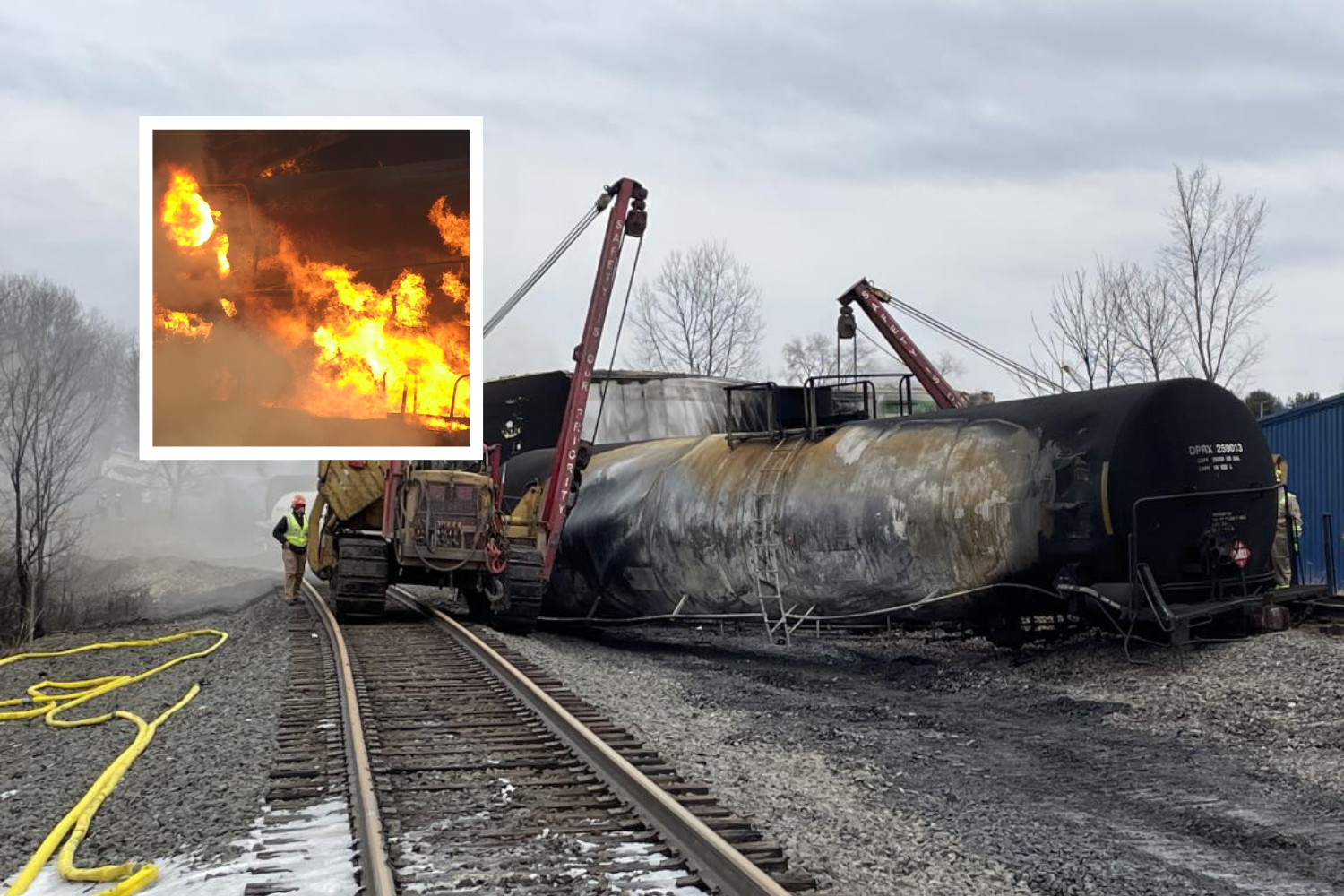Ohio Train Derailment: Long-Term Effects Of Toxic Chemical Exposure In Buildings

Table of Contents
Assessing the Extent of Building Contamination
Vinyl Chloride and its Persistence
Vinyl chloride, a known carcinogen, is a significant concern following the derailment. Its volatile nature allows it to easily penetrate porous building materials such as drywall, insulation, and even wood. This presents a significant challenge for remediation efforts, as the chemical can seep deep into structures, making complete removal incredibly difficult.
- Deep penetration: Vinyl chloride's small molecular size allows it to easily penetrate various building materials, making complete removal challenging.
- Incomplete remediation: Traditional cleaning methods may not be sufficient to eliminate all traces of vinyl chloride from affected buildings. Specialized techniques are required.
- Specialized testing: Advanced detection equipment, like gas chromatography-mass spectrometry (GC-MS), is necessary to accurately identify and quantify vinyl chloride levels in building materials and air.
Other Released Chemicals and Their Impact
Beyond vinyl chloride, the derailment released other hazardous chemicals, contributing to the overall contamination. These substances, depending on their properties and concentrations, can also impact building materials and pose long-term health risks.
- Other significant chemicals: The released chemicals included butyl acrylate, ethylhexyl acrylate, and ethylene glycol monobutyl ether, among others, each with its own potential health consequences.
- Diverse health risks: Exposure to these chemicals can lead to a range of health issues, from respiratory problems and skin irritation to more severe long-term effects.
- Material-specific impact: Different building materials react differently to these chemicals. For example, paint may absorb certain chemicals, while others may penetrate porous materials like insulation.
The Role of Environmental Testing
Comprehensive environmental testing is crucial to accurately assess the extent of contamination in affected buildings. This involves a multi-faceted approach using various testing methods to identify the presence and concentration of hazardous chemicals.
- Testing methods: Techniques include air sampling, material sampling (e.g., taking samples of drywall, insulation), and surface wipe testing.
- Certified professionals: It's critical to utilize certified environmental professionals with expertise in handling hazardous materials and interpreting test results.
- Repeated testing: Ongoing monitoring through repeated testing is vital to track remediation progress and ensure the long-term safety of buildings.
Long-Term Health Risks Associated with Chemical Exposure
Respiratory Issues and Cancer Risks
Exposure to vinyl chloride and other released chemicals poses significant long-term health risks, particularly concerning respiratory issues and cancer. Vinyl chloride is a known human carcinogen, linked to an increased risk of various cancers, including liver cancer.
- Respiratory problems: Exposure can lead to chronic respiratory illnesses like asthma, bronchitis, and emphysema.
- Cancer risks: Long-term exposure to vinyl chloride and other carcinogens significantly increases the risk of developing various cancers.
- Vulnerable populations: Children, the elderly, and individuals with pre-existing respiratory conditions are particularly vulnerable to the adverse effects of chemical exposure.
Neurological Effects and Other Health Concerns
The long-term health effects extend beyond respiratory problems and cancer. Exposure to the released chemicals may also lead to neurological problems, reproductive issues, and cardiovascular diseases.
- Neurological effects: Symptoms can include headaches, dizziness, memory loss, and cognitive impairment.
- Reproductive issues: Some chemicals can disrupt the endocrine system, leading to reproductive problems.
- Cardiovascular diseases: Exposure may increase the risk of developing heart and blood vessel diseases.
Remediation Strategies and Long-Term Building Safety
Decontamination and Remediation Techniques
Effective remediation strategies are crucial to mitigate the long-term risks associated with building contamination. Several techniques can be employed, depending on the extent and nature of the contamination.
- Air scrubbing: Specialized air filtration systems can remove harmful chemicals from the air.
- Surface cleaning: Cleaning and decontamination of surfaces using appropriate chemicals and methods can reduce contamination levels.
- Material replacement: In cases of severe contamination, replacement of severely affected building materials may be necessary.
Ensuring Ongoing Safety and Monitoring
Long-term monitoring and community engagement are vital to ensure building safety and the well-being of residents. Continuous monitoring of air quality and material integrity is crucial after remediation.
- Long-term monitoring plans: Regular air and material testing should be conducted to detect any resurgence of contamination.
- Community engagement: Open communication and participation of affected residents are essential for effective remediation and ongoing monitoring.
- Government agencies and health professionals: Collaboration between government agencies, healthcare providers, and environmental specialists is crucial for coordinating response efforts and providing necessary support to the community.
Conclusion
The Ohio train derailment highlights the devastating and long-lasting consequences of toxic chemical exposure on buildings and their inhabitants. The potential for long-term health risks associated with vinyl chloride and other released chemicals necessitates thorough environmental testing, effective remediation strategies, and ongoing monitoring to ensure the safety and well-being of the community. Understanding the complexities of building contamination and its health implications is crucial to preventing future tragedies and protecting vulnerable populations. Continue to stay informed about the ongoing Ohio train derailment and its implications for toxic chemical exposure in your community, seeking out reliable sources for the latest information and support for remediation and health concerns.

Featured Posts
-
 El Impacto De Retegui Candidato A La Bota De Oro
Apr 25, 2025
El Impacto De Retegui Candidato A La Bota De Oro
Apr 25, 2025 -
 Pope Francis Funeral Preceded By Public Viewing At St Peters
Apr 25, 2025
Pope Francis Funeral Preceded By Public Viewing At St Peters
Apr 25, 2025 -
 Eurovision Director Rejects Boycott Calls Over Israel
Apr 25, 2025
Eurovision Director Rejects Boycott Calls Over Israel
Apr 25, 2025 -
 Morning Docket April 2 2025 Above The Law
Apr 25, 2025
Morning Docket April 2 2025 Above The Law
Apr 25, 2025 -
 Boeings China Jet Deliveries At Risk Amid Airline Acceptance Concerns
Apr 25, 2025
Boeings China Jet Deliveries At Risk Amid Airline Acceptance Concerns
Apr 25, 2025
Latest Posts
-
 Understanding Stock Market Valuations Bof As Perspective For Investors
Apr 26, 2025
Understanding Stock Market Valuations Bof As Perspective For Investors
Apr 26, 2025 -
 Bof As View Why Current Stock Market Valuations Are Not A Cause For Alarm
Apr 26, 2025
Bof As View Why Current Stock Market Valuations Are Not A Cause For Alarm
Apr 26, 2025 -
 Los Angeles Palisades Fire A List Of Celebrities Whose Homes Were Damaged Or Destroyed
Apr 26, 2025
Los Angeles Palisades Fire A List Of Celebrities Whose Homes Were Damaged Or Destroyed
Apr 26, 2025 -
 The China Factor Analyzing The Difficulties Faced By Bmw Porsche And Other Auto Brands
Apr 26, 2025
The China Factor Analyzing The Difficulties Faced By Bmw Porsche And Other Auto Brands
Apr 26, 2025 -
 The Growing Problem Of Betting On Natural Disasters Focus On Los Angeles
Apr 26, 2025
The Growing Problem Of Betting On Natural Disasters Focus On Los Angeles
Apr 26, 2025
